
current / archive / issues / faq / RSS feed / twitter /
Blog Archive: October 2020
The World According To ... Faustus!This issue of Marvel Team-Up claims to be a team-up between Spider-man and The Fantastic Four, but it's not really that at all. It's partly a continuation of the previous issue's team-up with Mr Fantastic, with the rest of the FF appearing as helpless victims of the main villain Dr Faustus, who is the real star of the issue with the main story concerning his creepy relationship with a character called Anna.
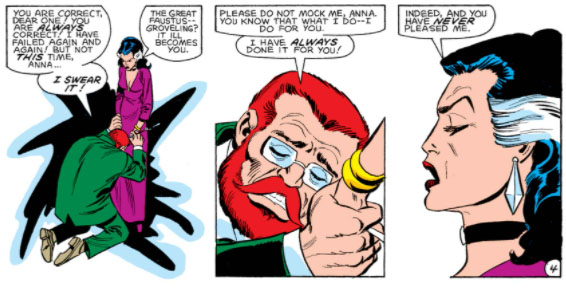 We're meant to think that Anna is Faustus' wife, but (SPOILERS) when we reach the end of the story it turns out that she was never there at all - she was some mysterious projection of Faustus' mind! OOooOOooOh!
We're meant to think that Anna is Faustus' wife, but (SPOILERS) when we reach the end of the story it turns out that she was never there at all - she was some mysterious projection of Faustus' mind! OOooOOooOh!
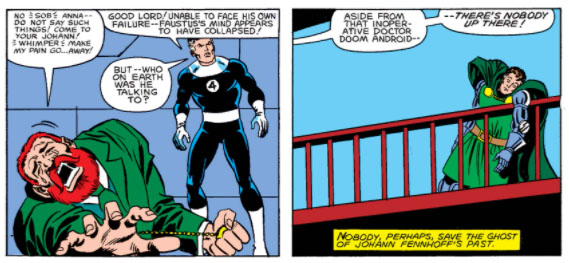 This is not quite as surprising as it was probably meant to be, largely because this is an extremely common story point used again and again, notably in "Psycho". The very end of the story even goes so far as to say that Anna was actually the main character's mother all along!
This is not quite as surprising as it was probably meant to be, largely because this is an extremely common story point used again and again, notably in "Psycho". The very end of the story even goes so far as to say that Anna was actually the main character's mother all along!
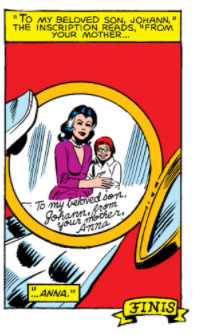 As shown above, Doctor Doom doesn't really appear at all, despite being shown on the cover. He's actually a robot used as part of Faustus' incredibly complicated scheme to drive Mr Fantastic mad through screwing about with his mind.
As shown above, Doctor Doom doesn't really appear at all, despite being shown on the cover. He's actually a robot used as part of Faustus' incredibly complicated scheme to drive Mr Fantastic mad through screwing about with his mind.
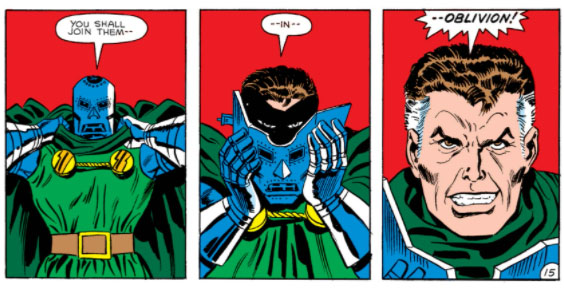 The scheme fails because Mr Fantastic was able to tell the difference between his actual wife and the robot that Faustus used on him - I'm only surprised that this gigantic flaw doesn't bring down more Evil Schemes. For instance, Arcade is forever fooling people into mistaking robots for loved ones they interact with every day, which doesn't seem hugely likely however amazing the robot is. Actually, this story does very much remind me of Arcade stories, as all sorts of impossible and weird things happen which get explained half-heartedly at the end as down to mirrors, robots, or, in this case, suction cups.
The scheme fails because Mr Fantastic was able to tell the difference between his actual wife and the robot that Faustus used on him - I'm only surprised that this gigantic flaw doesn't bring down more Evil Schemes. For instance, Arcade is forever fooling people into mistaking robots for loved ones they interact with every day, which doesn't seem hugely likely however amazing the robot is. Actually, this story does very much remind me of Arcade stories, as all sorts of impossible and weird things happen which get explained half-heartedly at the end as down to mirrors, robots, or, in this case, suction cups.
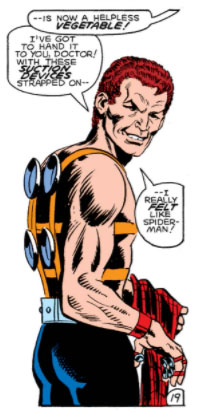 It's all a bit crappy to be honest, but better things lie ahead for us as next week we embark upon a three-part story back over in the pages of Fantastic Four that is full of Doctor Doom, kicking off with an entire issue all about him - next time!
It's all a bit crappy to be honest, but better things lie ahead for us as next week we embark upon a three-part story back over in the pages of Fantastic Four that is full of Doctor Doom, kicking off with an entire issue all about him - next time!
posted 29/10/2020 by MJ Hibbett
(click here for permanent link)
(0) comments
The Witch's Tale!
When I first started buying US Marvel comics, back in the 1980s, it was pretty much impossible to buy consecutive issues of any series. Around the middle of the decade I discovered the stall on Peterborough market (that would later become "The House On The Borderland" shop ) which sold all the American comics, but before then it was a case of wandering round different newsagents seeing which random issues they'd been given that month.
Desperation often lead to me spending my pocket money on whatever comics were available, and sometimes this would involve issues of Roger Stern's run on The Avengers which, like this one, were so heavily entwined with continuity they were almost impossible to follow. The first few pages of this story tell interweaving stories of the daily life of the team's various members, some of which are only told within this series (such as She-Hulk's relationship with the never not creepy Starfox) and others which go back and forth between the solo series of characters like Iron Man, Thor and Captain America. It's a breezy, very soap opera-like way of storytelling but it was extremely confusing if you lived in Peterborough and weren't able to tune into most of the other episodes!
Doctor Doom appears in the second half of the comic, which is almost entirely taken up with a re-telling of the Scarlet Witch's life story. Doom's job, as it so often seems to be, is to represent All Supervillains in a single panel which covers most of The Scarlet Witch's early adventures with the team - despite the fact that many other villains appeared much more often.
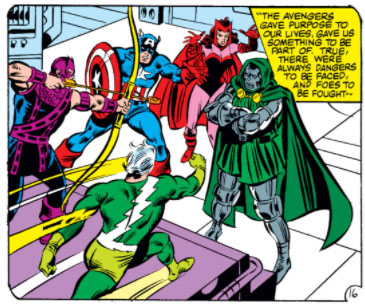 The overall story rolls along and then comes to a sudden halt with a non-cliffhanger ending where Doctor Strange shows up in Astral Projection form and... that's it!
The overall story rolls along and then comes to a sudden halt with a non-cliffhanger ending where Doctor Strange shows up in Astral Projection form and... that's it!
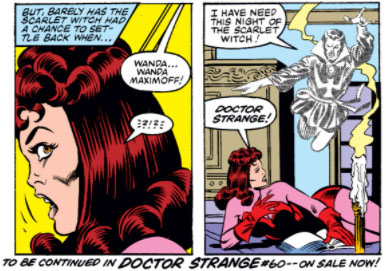 It's very much in keeping with the style of the entire issue, which clearly sees itself very much as a single piece in a much bigger jigsaw, rather than a stand-alone story. As we'll see soon, Roger Stern would collaborate with John Byrne later on aspects of this that had much more interesting results, but here it all feels a bit unsatisfactory, as you need to buy several other comics to get any idea what's going on in this one!
It's very much in keeping with the style of the entire issue, which clearly sees itself very much as a single piece in a much bigger jigsaw, rather than a stand-alone story. As we'll see soon, Roger Stern would collaborate with John Byrne later on aspects of this that had much more interesting results, but here it all feels a bit unsatisfactory, as you need to buy several other comics to get any idea what's going on in this one!
Next time we've got one more single panel appearance to go before we get a whole issue full of Doom. See you then for "The World According to... Faustus!"
posted 27/10/2020 by MJ Hibbett
(click here for permanent link)
(0) comments
Lifelines
I remember feeling distinctly unfavourable to this series when it first came out, as it was promoted as being by John Byrne and had his art on the cover, but inside it turns out that he only writes it. I didn't buy John Byrne comics for the writing, I thought, what was the point without his amazing artwork?
Reading this comic several decades later I think my younger self might have been a bit harsh - Ron Frenz inked by Joe Sinnot is perfectly acceptable, if a little stiff, and the writing's pretty much the same as in the main FF series - but this is definitely a bit of an underwhelming story to have for the first issue of a new superhero series. It sees Ben Grimm returning to his old stomping ground on Yancy Street where, in order to stop a young boy going into a life of crime, he gives him a recap of his own history, including the tragic demise of his big brother and childhood hero Dan Grimm in a knife fight.
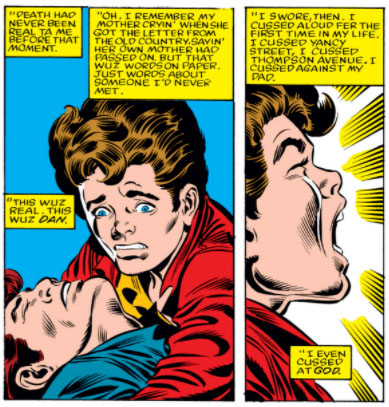 The story then moves on to a re-telling of the Fantastic Four's origin, as seems to be compulsory in first issues, including an incredibly brief glimpse of a young Victor von Doom during Ben and Reed's college days.
The story then moves on to a re-telling of the Fantastic Four's origin, as seems to be compulsory in first issues, including an incredibly brief glimpse of a young Victor von Doom during Ben and Reed's college days.
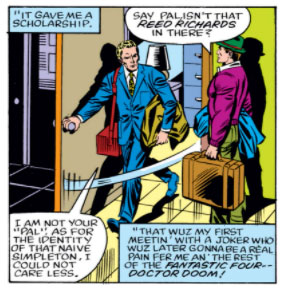 That's your lot for Doctor Doom, and the issue continues with Ben making his pitch to the youngster. However, in a marked change to the usual run of these things, after all that Ben's story does not turn the kid around in any way whatsoever!
That's your lot for Doctor Doom, and the issue continues with Ben making his pitch to the youngster. However, in a marked change to the usual run of these things, after all that Ben's story does not turn the kid around in any way whatsoever!
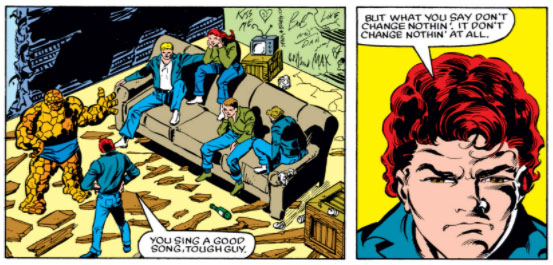 It all ends with The Thing shrugging his shoulders and going down the pub for a few beers with an old pal. While I really like this as a twist on the usual morality tales, it does make for a very downbeat, not exactly thrilling debut for what is, after all, meant to be a superhero series!
It all ends with The Thing shrugging his shoulders and going down the pub for a few beers with an old pal. While I really like this as a twist on the usual morality tales, it does make for a very downbeat, not exactly thrilling debut for what is, after all, meant to be a superhero series!
There's not much of Doom next time either I'm afraid, but we do get to see a prime example of a Marvel series existing almost entirely as a storytelling bridge, rather than a standalone issue. See you then!
posted 22/10/2020 by MJ Hibbett
(click here for permanent link)
(0) comments
Aftermath!
This issue sees the start of a short run of very minor appearances by Doctor Doom, often only popping in for a single panel flashback. Stick with it though, because when we're through these there's some very big Doom stories ahead!
This particular comic was the last issue of the long-running "Marvel Two-In-One" series, although it sort of returned a month later with the first issue of a solo series for The Thing, written by John Byrne as part of his "ownership" of the Fantastic Four franchise. He's also the writer for this final issue, but rather than using it to look back on the series as a whole (which was pretty much covered by all the returning villains in Visiting Hours a few months earlier) Byrne instead returns to his previous anniversary story for Marvel Two-In-One #50. That story saw Ben Grimm travelling back in time to give an earlier version of himself a cure for being The Thing (which would not have worked on his present self) then returning to his own time to discover that he had not changed history, and had instead created an alternate universe.
There's further fiddling about with The Rules Of Time Travel And Alternate Universes, as Ben travels to this alternate reality again, this time to the present day where he discovers an Earth that was devastated by Galactus.
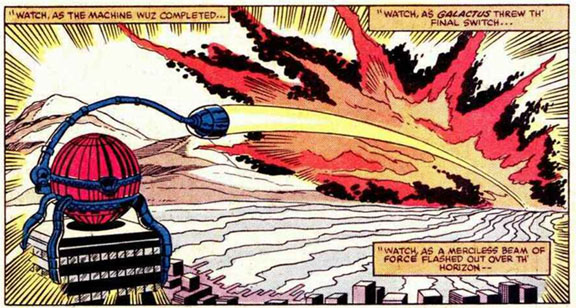 This has all happened because there was no Thing around as part of The Fantastic Four. After Ben Grimm was cured Spider-man was recruited into the team instead, and was clearly not as much use when it came to the big fight with Galactus, leaving it to the other heroes to try (and fail) to fight him off.
This has all happened because there was no Thing around as part of The Fantastic Four. After Ben Grimm was cured Spider-man was recruited into the team instead, and was clearly not as much use when it came to the big fight with Galactus, leaving it to the other heroes to try (and fail) to fight him off.
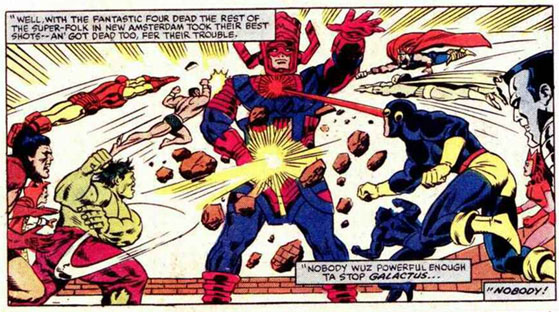 This section plays out like a "What If?" story, and as so often happens Doctor Doom is roped in to illustrate The Fantastic Four's many battles with him, this time with Spidey included.
This section plays out like a "What If?" story, and as so often happens Doctor Doom is roped in to illustrate The Fantastic Four's many battles with him, this time with Spidey included.
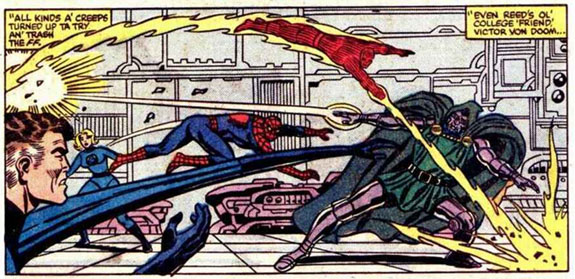 That's Doom's only appearance, and the story continues with The Thing discovering some other differences, notably that The Red Skull is now in charge of the planet. The Thing wasn't around in the very early days of the Fantastic Four, so never had an argument with The Human Torch that sent him to the dockside flophouses where he discovered the Submariner, who thus did not find Captain America in a block of ice, and so he in turn wasn't around to stop The Red Skull. It's all a bit of a head scratcher which leads to some alarming images of a broken Twin Towers with a colossal Nazi flag sticking out of one of the buildings.
That's Doom's only appearance, and the story continues with The Thing discovering some other differences, notably that The Red Skull is now in charge of the planet. The Thing wasn't around in the very early days of the Fantastic Four, so never had an argument with The Human Torch that sent him to the dockside flophouses where he discovered the Submariner, who thus did not find Captain America in a block of ice, and so he in turn wasn't around to stop The Red Skull. It's all a bit of a head scratcher which leads to some alarming images of a broken Twin Towers with a colossal Nazi flag sticking out of one of the buildings.
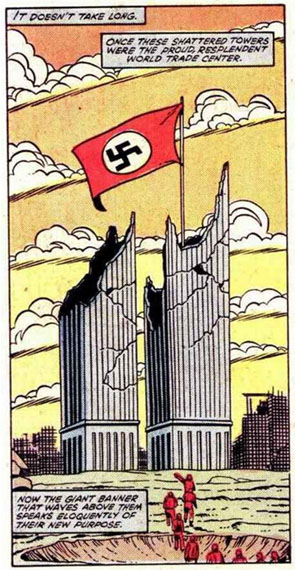 Or maybe it's a normal flag inside a model village? Working together, the two versions of Ben Grimm work together to defeat The Red Skull and free what's left of the planet from his rule. As our version of The Thing heads back to the Time Machine (which, John Byrne suggests, may not be a time machine at all, but instead a device to cross over into alternate dimensions) his counterpart reassures him that the end of the world wasn't his fault at all. This version of Galactus travelled solo, without a herald, so there was no Silver Surfer around to help defeat him.
Or maybe it's a normal flag inside a model village? Working together, the two versions of Ben Grimm work together to defeat The Red Skull and free what's left of the planet from his rule. As our version of The Thing heads back to the Time Machine (which, John Byrne suggests, may not be a time machine at all, but instead a device to cross over into alternate dimensions) his counterpart reassures him that the end of the world wasn't his fault at all. This version of Galactus travelled solo, without a herald, so there was no Silver Surfer around to help defeat him.
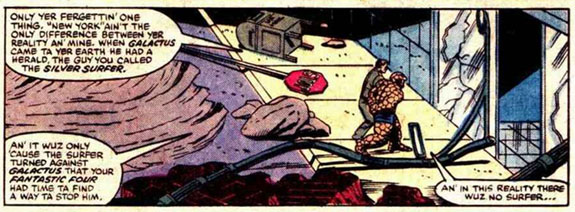 Phew, that's a relief! The story ends with The Thing back home in the Baxter Building, musing on the fact that, what with one thing and another, he's probably better off not being cured but still having Alicia, his friends, and his life as a superhero, rather than being a normal human being living in a blighted wasteleand. I'd have added "access to medicine, shops and telly" to that list of pros, but I think he might have a point!
Phew, that's a relief! The story ends with The Thing back home in the Baxter Building, musing on the fact that, what with one thing and another, he's probably better off not being cured but still having Alicia, his friends, and his life as a superhero, rather than being a normal human being living in a blighted wasteleand. I'd have added "access to medicine, shops and telly" to that list of pros, but I think he might have a point!
Next time another brief glimpse of Doom as we stick with John Byrne for the first issue of The Thing's new solo series!
posted 20/10/2020 by MJ Hibbett
(click here for permanent link)
(0) comments
Doctor Doom and Doctor Doom's Castle
"The Official Handbook Of The Marvel Universe" was an alphabetical list of all the major heroes and villains of the Marvel Universe, with lengthy descriptions of their history and abilities accompanied by loads of new artwork. It reads very much like a role-playing game manual, with specifics about everything from the battery life of Doom's rocket pack (3.6 years) to his height and weight. According to this, he is 6'2" and weights 225 pounds, which gives him a BMI of 28.8, putting him at the high end of overweight bordering on obese. I wouldn't want to be the GP who has to suggest he cuts down on the Latverian chocolates!
Initially I wasn't sure whether this issue should really be included in my corpus. It's meant to only include narrative texts, so things like the Doctor Doom costumes from Ben Cooper or the Slurpee Mugs don't feature in the final analysis. However, reading through Doom's entry here it's clear that there's definitely some narrative storytelling going rather than simply being a summing of things that were already known. For instance, alongside all the "data" about how his armour works (nuclear reactors and "micro-computers" apparently) we get all sorts of new history, like the former name of Doomstadt (Haasendstadt), the name of Castle Doom's original owner (Count Sabbat), and even some more detail about what went wrong in the accident that scarred his face. It was all to do with "an error in the execution of a fourth-order tensor calculation", which Reed Richards spotted but Doom "dismissed". I've just looked up what that means and am still none the wiser!
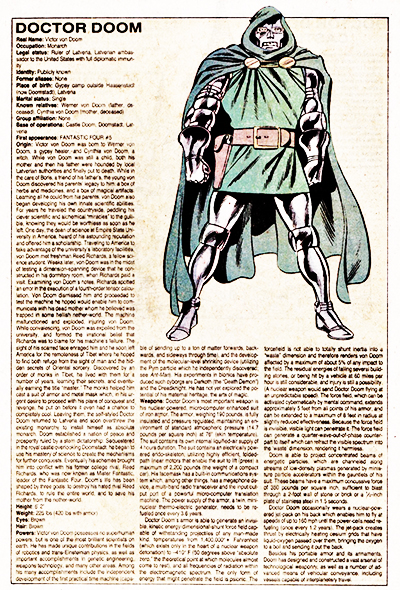 Ordinarily, when reading this sort of thing, I'd just assume that this was information that had previously been reported in the comics stories which I hadn't read or had forgotten. However, one of the great delights of this whole project is that I know for a fact that I have definitely read every single appearance of Doctor Doom, multiple times, and have written extensive notes in the form of this very blog, so I can say with some confidence that huge swathes of this information has just been made up for this isue!
Ordinarily, when reading this sort of thing, I'd just assume that this was information that had previously been reported in the comics stories which I hadn't read or had forgotten. However, one of the great delights of this whole project is that I know for a fact that I have definitely read every single appearance of Doctor Doom, multiple times, and have written extensive notes in the form of this very blog, so I can say with some confidence that huge swathes of this information has just been made up for this isue!
Now, obviously, one could legitimately say that all of the information about Doctor Doom in every text has just been made up, but the storyworld of the Marvel Universe is one which has come to value consistency and even uses citation as a major part of its world-building. Whenever somebody refers to a past event there's almost always a footnote at the bottom of the panel which tells you which back-issue the event can be found in, and the whole tone of this "handbook" is of a definitive record of precisely what has occurred and how things work. I've already says that it resembles an RPG rulebook, but it also functions as a Grand Argument Decider - if two fans disagree about, for instance, how powerful Doom's gauntlet-based rock-projector weapons are, this mighty tome will settle it once and for all. They "have a maximum concussive force of 350 pounds per square inch, sufficient to blast through a 2-foot wall of stone or brick or a half-inch plate of stainless steel in 1.5 seconds." Good to know!
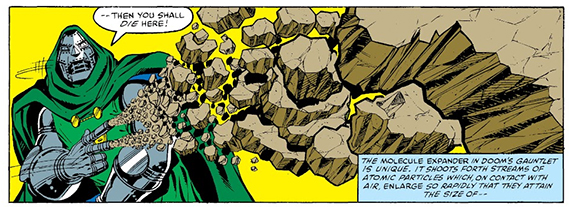 Doom gets two pages in this issue, denoting his status as a major player in the Marvel Universe, with the second page dedicated to a history of his "huge 110 room castle built in the 16th Century" (and as we know, rebuilt on a number of occasions since). This includes an aerial view of the castle which takes a slightly revised version of Jack Kirby's version from Fantastic Four #84 and creates an answer to the traditional Baxter Building cutaway, showing exactly what goes on where.
Doom gets two pages in this issue, denoting his status as a major player in the Marvel Universe, with the second page dedicated to a history of his "huge 110 room castle built in the 16th Century" (and as we know, rebuilt on a number of occasions since). This includes an aerial view of the castle which takes a slightly revised version of Jack Kirby's version from Fantastic Four #84 and creates an answer to the traditional Baxter Building cutaway, showing exactly what goes on where.
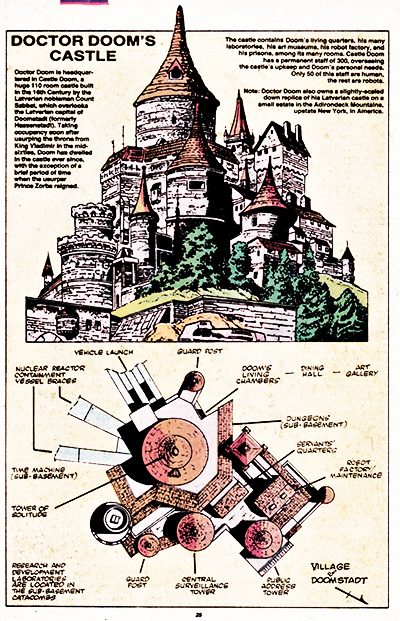 This has clearly been done with some care, trying to match the diagram's layout to Kirby's original, and the fact that the image on the previous page was drawn by Byrne leads me to assume this is another of his very careful attempts to re-map historical continuity. It's a lovely job, I wonder if anybody ever actually used it?
This has clearly been done with some care, trying to match the diagram's layout to Kirby's original, and the fact that the image on the previous page was drawn by Byrne leads me to assume this is another of his very careful attempts to re-map historical continuity. It's a lovely job, I wonder if anybody ever actually used it?
In fact, I wonder if this was ever used as an actual "official handbook" within Marvel itself, with writers asked to refer to it for future continuity references? It doesn't seem particularly likely, but I guess we'll find out as we carry on through the sample. We'll be back in Latveria with John Byrne in a couple of weeks, which should be a good place to assess this, but before then we have yet more cameos and flashbacks to get through, starting next time with the landmark 100th (and final) issue of "Marvel Two-In-One"!
posted 13/10/2020 by MJ Hibbett
(click here for permanent link)
(0) comments
Visiting Hours!
This story is advertised on the splash page as "a truly offbeat adventure of The Thing", and it sort of is... though as we'll see it also harks back to an early classic from the Marvel Universe.
It's called "offbeat" because The Thing himself spends the entire issue sitting in bed in hospital, recovering from various thumpings he's had in recent issues of The Fantastic Four and his own title. He'd rather be at home, but according to Mr Fantastic he's better off here, in a totally normal hospital, rather than in the super-duper futuristic science centre at The Baxter Building.
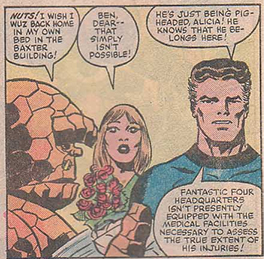 Can that really be right? I'm pretty sure I've seen some medical gizmoes at the FF's base, so maybe Reed Richards has run out of plasters or something? Quite apart from that not making sense, the other big issue is that this really is just a hospital, without the defences available at The Baxter Building.
Can that really be right? I'm pretty sure I've seen some medical gizmoes at the FF's base, so maybe Reed Richards has run out of plasters or something? Quite apart from that not making sense, the other big issue is that this really is just a hospital, without the defences available at The Baxter Building.
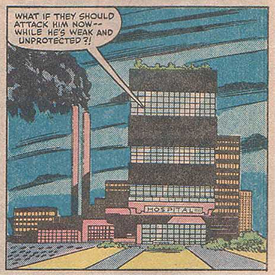 It's a bit of a daft set-up, but it does lead into a very enjoyable story which sees pretty much the entire Marvel Universe of the time being called up to protect the Thing from all the super-villains who've found out that he's vulnerable. It reminded me of "The Wedding Of Reed Richards And Sue Storm" in Fantastic Four Annual #3.
It's a bit of a daft set-up, but it does lead into a very enjoyable story which sees pretty much the entire Marvel Universe of the time being called up to protect the Thing from all the super-villains who've found out that he's vulnerable. It reminded me of "The Wedding Of Reed Richards And Sue Storm" in Fantastic Four Annual #3.
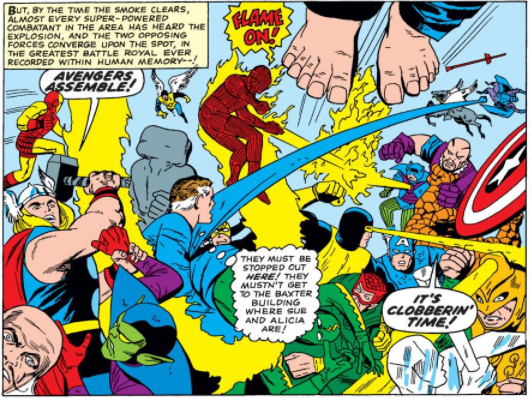 To my enormous delight, the half-page appearance by Doctor Doom seems to confirm that this was intentional, when we see him reading about the news of The Things's hospitalisation in the pages of The Daily Bugle.
To my enormous delight, the half-page appearance by Doctor Doom seems to confirm that this was intentional, when we see him reading about the news of The Things's hospitalisation in the pages of The Daily Bugle.
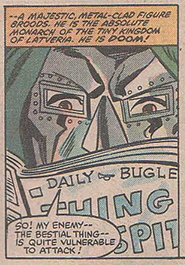 This is a direct echo of the way that Doom learnt about Reed and Sue's wedding all those years ago - so long ago, in fact, that it was before he took out his Daily Bugle subscription!
This is a direct echo of the way that Doom learnt about Reed and Sue's wedding all those years ago - so long ago, in fact, that it was before he took out his Daily Bugle subscription!
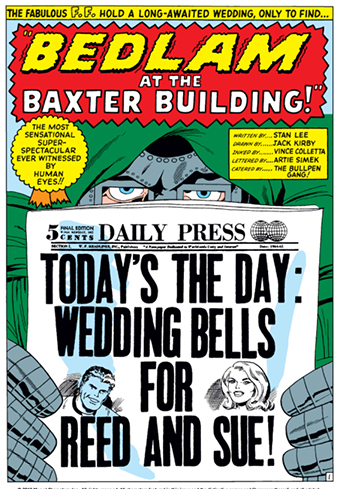 Then, as now, he takes out his frustration on the newspaper itself, although in the intervening years we can see that Doom's character has changed. Back in the 1960s he was happy to attack his foes when they were vulnerable, whereas now he feels that this would be beneath him.
Then, as now, he takes out his frustration on the newspaper itself, although in the intervening years we can see that Doom's character has changed. Back in the 1960s he was happy to attack his foes when they were vulnerable, whereas now he feels that this would be beneath him.
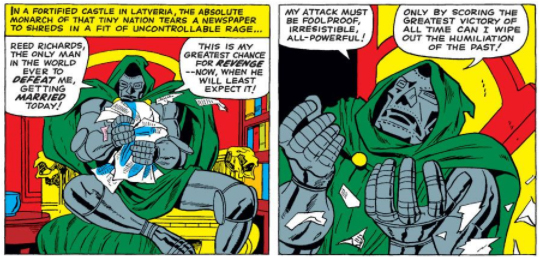
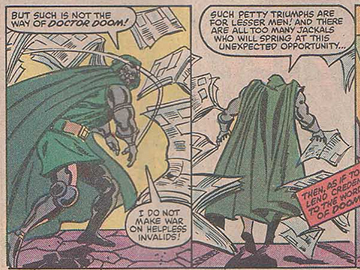 It's a lovely, rather subtle, use of quotation which would be likely to pass most people by - it's only today, reading the comic for the third or fourth time, that I noticed it myself! It also demonstrates how Doom's portrayal has changed since then, or perhaps solidified. During the Lee and Kirby run on Fantastic Four he started out as a villain, became a sort of tragic hero, and then regressed back into being a villain again as an Eastern European dictator towards the end, while simultaneously being portrayed much more sympathetically by other creators in other titles. Now, led by John Byrne's version in The Fantastic Four, he is solidly depicted as a man of honour who will not kick his enemy while he's down.
It's a lovely, rather subtle, use of quotation which would be likely to pass most people by - it's only today, reading the comic for the third or fourth time, that I noticed it myself! It also demonstrates how Doom's portrayal has changed since then, or perhaps solidified. During the Lee and Kirby run on Fantastic Four he started out as a villain, became a sort of tragic hero, and then regressed back into being a villain again as an Eastern European dictator towards the end, while simultaneously being portrayed much more sympathetically by other creators in other titles. Now, led by John Byrne's version in The Fantastic Four, he is solidly depicted as a man of honour who will not kick his enemy while he's down.
Doom might not want to do that, but plenty of others will have a go, and the story reaches a climax with a mass brawl between superheroes and villains. It's a nice illustration of who the main characters of the Marvel Universe were considered to be in 1983, compared to the ones we saw twenty-ish years earlier.
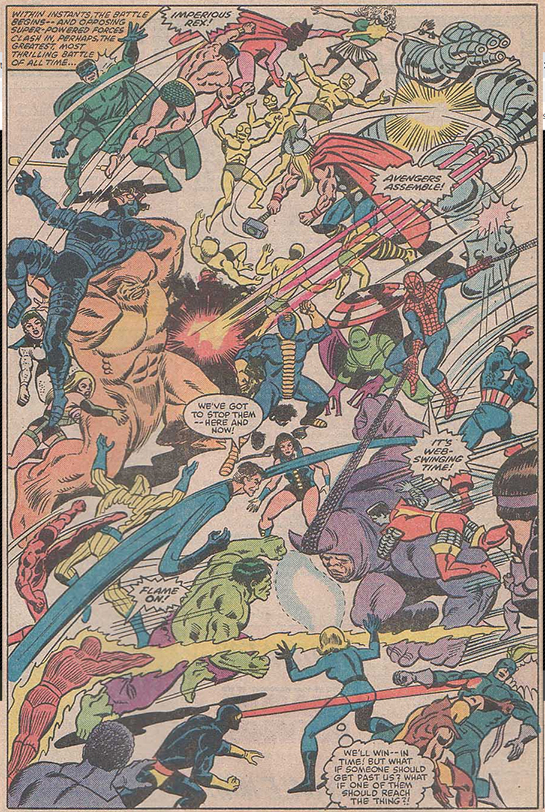 The comic itself ends with a much quieter scene, as The Sandman sneaks in to thank The Thing for helping him get straight in an earlier issue. He's brought a couple of presents with him, and the issue closes with the pair of them enjoying a good old healthy dose of beer and cigars!
The comic itself ends with a much quieter scene, as The Sandman sneaks in to thank The Thing for helping him get straight in an earlier issue. He's brought a couple of presents with him, and the issue closes with the pair of them enjoying a good old healthy dose of beer and cigars!
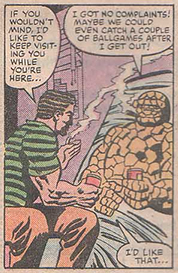 It's a sweet ending, if very very much of its time, for a jolly story that not only wears its continuity lightly, but also uses it to have a look at how much the Marvel Universe has changed. More of this sort of thing please!
It's a sweet ending, if very very much of its time, for a jolly story that not only wears its continuity lightly, but also uses it to have a look at how much the Marvel Universe has changed. More of this sort of thing please!
posted 6/10/2020 by MJ Hibbett
(click here for permanent link)
(0) comments
Gather My Disciples Before Me
I've never read many Doctor Strange stories, and so have always assumed that they were fairly standard superhero stories with a bit of magical stuff layered over the top - something like Daredevil, but with hocus pocus instead of dirty alleyways. Thus I was a bit surprised when I read this comic and found that it wasn't particularly superhero-y at all, it's much more like a early Sunday evening TV detective show, where the hero spends most of his time just trying to get on with the business of running his consultancy - with the help of his manservant and social secretary - as well as his love life.
It's quite a pleasant read, something which is helped very much by the art of Kevin Nowland inked by Terry Austin. It does look very much of its time, but if you like the art of that time (as I do), it's a lovely looking comic.
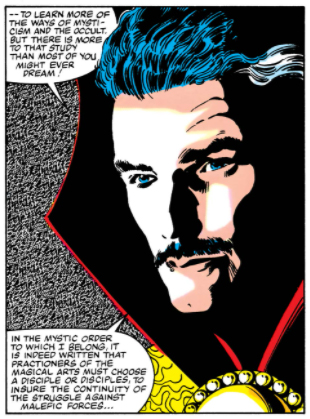 The main story is about Doctor Strange being hassled by various wannabes who've heard that his disciple, Clea, has left, and so have decided that he must want to take somebody new on. This leads to mildly comical scenes as hordes of people gather outside the Sanctum Sanctorum demanding to see Brian... sorry, the Sorceror Supreme.
The main story is about Doctor Strange being hassled by various wannabes who've heard that his disciple, Clea, has left, and so have decided that he must want to take somebody new on. This leads to mildly comical scenes as hordes of people gather outside the Sanctum Sanctorum demanding to see Brian... sorry, the Sorceror Supreme.
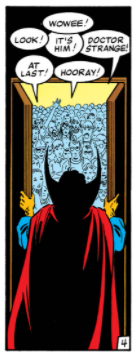 Doctor Doom's appearance takes place on a page all to himself, set in Latveria, where a small child comes to tell him that Doctor Strange is without a disciple. A few years previously we might have expected Doom to send the child packing, furious that she has dared to suggest he'd been interested in a "lesser" mystic, but here, very much in line with the character we saw in This Land Is Mine, he thanks her for letting him know.
Doctor Doom's appearance takes place on a page all to himself, set in Latveria, where a small child comes to tell him that Doctor Strange is without a disciple. A few years previously we might have expected Doom to send the child packing, furious that she has dared to suggest he'd been interested in a "lesser" mystic, but here, very much in line with the character we saw in This Land Is Mine, he thanks her for letting him know.
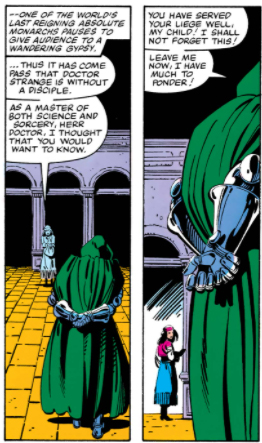 He then wanders off to the battlements for a bit of a think, as he is so often wont to do, and reflects upon the recent events. "Latveria is still in the throes of reconstruction... still recovering from the rule of the usurper Zorba!" he thinks, before deciding to stay at home rather than seek out the knowledge of Doctor Strange... at least for now.
He then wanders off to the battlements for a bit of a think, as he is so often wont to do, and reflects upon the recent events. "Latveria is still in the throes of reconstruction... still recovering from the rule of the usurper Zorba!" he thinks, before deciding to stay at home rather than seek out the knowledge of Doctor Strange... at least for now.
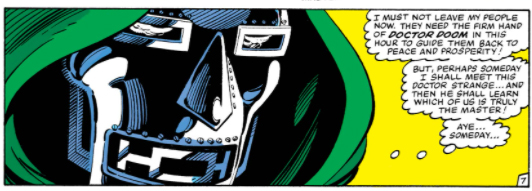 It's a delightful little cameo that doesn't move this specific story anywhere at all, but does lay the groundwork for Roger Stern and Mike Mignola's "Triumph And Torment" graphic novel, where the two do meet. I wonder if Stern had that in mind here, six years earlier? It must have some significance because, as we'll see in a few weeks, this exact same scene will crop up again somewhere else...
It's a delightful little cameo that doesn't move this specific story anywhere at all, but does lay the groundwork for Roger Stern and Mike Mignola's "Triumph And Torment" graphic novel, where the two do meet. I wonder if Stern had that in mind here, six years earlier? It must have some significance because, as we'll see in a few weeks, this exact same scene will crop up again somewhere else...
The main story then continues, with Strange arranging a "testing" in front of an audience of the wannabes, during which he discovers that "The Sorceress Supreme" is behind it all. They have a Big Fight, and he realises that she herself is being controlled by an Evil Wand, which he grabs and smashes, freeing her and her daughter from its possession.
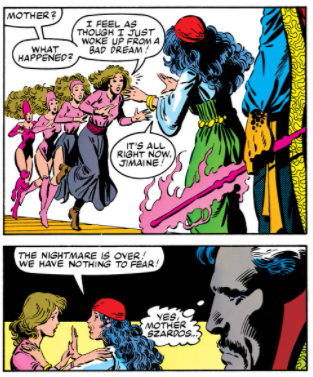 I am pretty sure there is something Freudian to say here about Wands controlling Magical Women - though not by me!
I am pretty sure there is something Freudian to say here about Wands controlling Magical Women - though not by me!
All that remains is for Doctor Strange to do some Mind Control on the other candidates so that they forget it ever happened, which he seems to do without any thought for the ethics of such actions, and that's the end of the story. It's a very gentle read and, to be honest, one which you wouldn't really miss if your memory got mystically wiped, but it's worth it just to get that little bit of Doom!
posted 1/10/2020 by MJ Hibbett
(click here for permanent link)
(0) comments